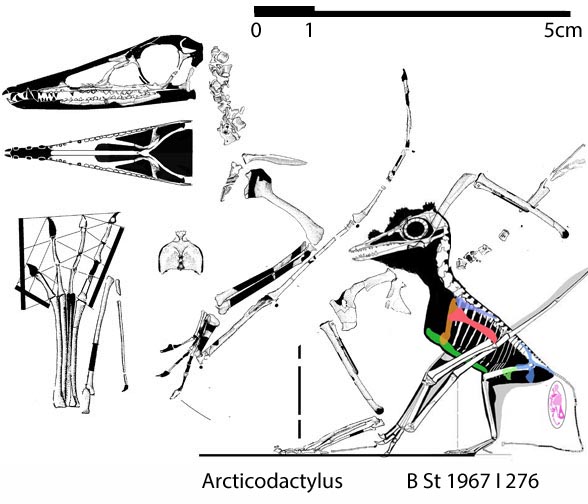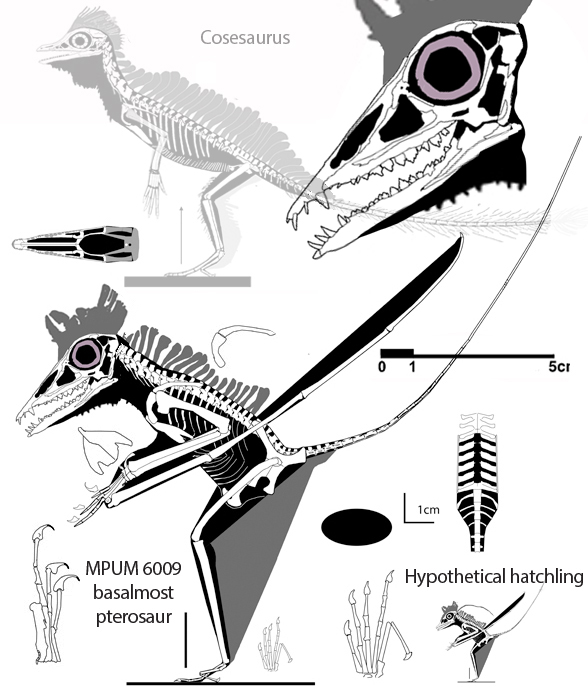Fitch et al. 2021 took a third look
at the Greenland Triassic eudimorphodontid pterosaur, Arcticodactylus (Fig. 1; Kellner 2015, originally Eudimorphodon Jenkins et al. 1999; MGUH VP 3393).
Fitch et al. wrote:
“Pterosaurs represent the earliest-appearing of only three clades of flying vertebrates, the pioneers of aerial vertebrate ecospace, and the lineage to produce the largest known flying organism.”
Once again, the largest pterosaurs, the azhdarchids, only became large AFTER they became flightless due to having vestigial distal wing phalanges.
It’s also an unnecessary trope that workers feel like they have to explain what pterosaurs are and what they did first. The audience for these abstracts KNOWS what pterosaurs are and what they did first.
“The origins of the pterosaurian flight apparatus have been difficult to ascertain, in part due to incomplete or two-dimensional preservation of the earliest (Triassic–Jurassic) pterosaur remains.”
Not difficult to ascertain. This is something we’ve known for twenty years. For reasons I still cannot fathom, pterosaur workers still don’t want to review or acknowledge Peters 2000 who presented four pterosaur precursors tested by adding these taxa to four prior phylogenetic analyses. Subsequently the large reptile tree (LRT, 1991 taxa) confirmed these taxa as pterosaur precursors. Peters 2002 explored the origin of pterosaur wings. Peters 2007 moved pterosaurs and kin to Lepidosauria.
For more information on pterosaur wing evolution, click here.

Fitch et al. 2021 continue:
“An exceptional early pterosaur specimen that is preserved in three dimensions, the holotype and only known specimen of Arcticodactylus cromptonellus (Upper Triassic; Fleming Fjord Formation, Greenland) may help address these problems. However, it has remained mostly encased within matrix to protect the delicate elements, obscuring external study.”
What you see here (Fig. 1) is all that was originally published by Jenkins et al. 1999.
“Here we present new synchrotron tomographic scan data of the forelimb (wing-forming)
elements of Arcticodactylus cromptonellus. The forelimb of Arcticodactylus possesses a number of features plesiomorphic to Ornithodira (birds+pterosaurs),”
Ornithodira = dinosaurs + pterosaurs and all their descendants. Since pterosaurs don’t nest with dinosaurs in the LRT, Ornithodira is a junior synonym for the clade Reptilia (= Amniota).
“…including the extension of the phalangeal articular surfaces onto the dorsal surface of metacarpals II–III and manual asymmetry (metacarpal I/metacarpal II length ≤ 0.80), the latter of which is absent in all but two other Triassic pterosaur taxa (Carniadactylus and Seazzadactylus).”
Nobody seems to care that pterosaurs had a longest digit 4, which is not found in Archosauria, but is found in Lepidosauria. Additionally, the most primitive pterosaur in the LRT and large pterosaur tree (LPT, 260 taxa), Bergamodactylus (Fig. 2), likewise preserves manual asymmetry.
Fitch et al. 2021 continue:
“Arcticodactylus also possesses several hallmarks of the early pterosaurian wing: a deltopectoral crest that is wider than the humeral mediolateral midshaft width, a fourth digit that is longer than the rest of the forelimb, a fourth metacarpal possessing a ‘roller joint’ articulation with the fourth digit, and a crista metacarpi present on the posterior face of this metacarpal. Notably, the humeral deltopectoral crest of Arcticodactylus possesses a straight proximal margin and is separated from the humeral head by a distinct, laterally-facing margin, features found in early ornithodirans but absent in other pterosaurs.”
Which ‘early ornithodirans’? Herrerasaurus (Fig. 3)? Does Fitch et al. know they are cherry-picking traits without an overall phylogenetic analysis that includes a wide gamut of taxa?
Fitch et al. 2021 continue:
“The presence of a mosaic of anatomical features found in the forelimbs of early-diverging
ornithodirans and of winged pterosaurs (including some found in only the very earliest-diverging pterosaurs) demonstrates that, rather than possessing a “fully developed” pterosaur wing, Arcticodactylus is a structural intermediate between early archosaurs and derived pterosaurs.”
In the LPT Arcticodactlyus nests with Eudimorphodon ranzii (Fig. 4),
five nodes from the base of the Pterosauria.

Fitch et al. 2021 continue:
“Other Triassic pterosaur specimens, similarly assumed to represent irrelevant “developed” forms, may also preserve distinct, intermediate morphologies that inform the evolution of the pterosaur forelimb from that of terrestrial archosaurs.”
Irrelevant? Developed? Intermediate? Why not just add all these taxa to a phylogenetic analysis. Then you’ll have that cladogram for the rest of your career and you can use it with authority. It’s evidence, not conjecture, not opinion. It shows you did the work and understand relationships from evidence, without bias.

References
Fitch AJ, Bhullar B-A, Pritchard AC, Bevit J, Lovelace DM and Nesbitt S 2021. The forelimb of Articodactylus cromptonellus (Pan-Aves; Pterosauria) and the assembly of the pterosaur wing. Journal of Vertebrate Paleontology abstracts.
Jenkins FA Jr, Shubin NH, Gatesy SM and Padian K 1999. A diminutive pterosaur (Pterosauria: Eudimorphodontidae) from the Greenlandic Triassic. Bulletin of the Museum of Comparative Zoology, Harvard University 155(9): 487-506.
Peters D 2000. A Redescription of Four Prolacertiform Genera and Implications for Pterosaur Phylogenesis. Rivista Italiana di Paleontologia e Stratigrafia 106 (3): 293–336.
Peters D 2002. A New Model for the Evolution of the Pterosaur Wing – with a twist. – Historical Biology 15: 277–301.
Peters D 2007. The origin and radiation of the Pterosauria. In D. Hone ed. Flugsaurier. The Wellnhofer pterosaur meeting, 2007, Munich, Germany. p. 27.


